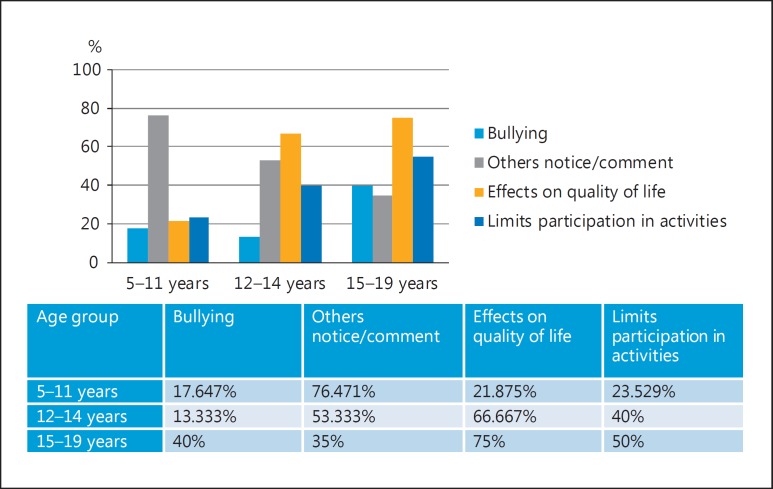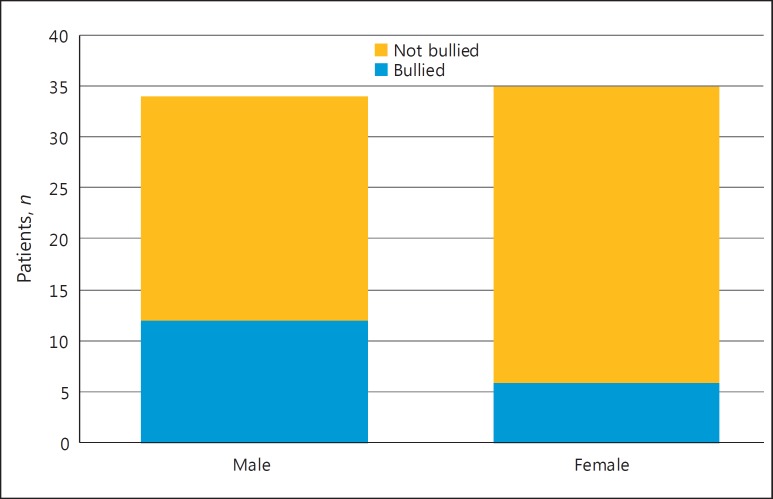Abstract
Alopecia areata (AA) is a clinically heterogeneous disease that is characterized by nonscarring hair loss, nail changes, and increased risk of other autoimmune disease. During clinical visits, children with AA often report bullying. We report survey results that highlight the prevalence of bullying and surrounding emotional impact of AA in pediatric patients. We found that bullying was common overall and additional psychological impact, including impairment of social and home life, was even more common. Children of all ages experienced bullying. Boys reported increased physical bullying. Interestingly, those with more severe disease and longer duration of disease experienced less bullying than those with less severe disease.
Keywords: Alopecia areata, Quality of life, Bullying
Alopecia areata (AA) is characterized by nonscarring hair loss, nail changes, and increased risk of other autoimmune disease. AA is clinically heterogeneous, and its natural history is unpredictable in terms of duration, extent, hair loss pattern, and time of initial onset [1]. Approximately 66% of AA patients are diagnosed before the age of 30 years [2]. AA is associated with a high psychological burden [3, 4]. In order to better understand the emotional well-being, mental health, and social functioning of patients with alopecia, researchers have begun using a new quality of life scale: the Alopecia Areata Symptom Impact Scale (AASIS) [5, 6]. This scale, however, does not address bullying in children. We report survey results that highlight the prevalence of bullying and surrounding emotional impact of AA in pediatric patients. Our surveys were composed of 13 questions for parents of children aged between 5 and 21 years and a survey of 14 questions for patients aged between 14 and 21 years. The additional question for adolescents asked patients how concerned they were about their parents' worry about their disease.
Sixty-nine AA patients and their parents attending the Section of Pediatric Dermatology, Children's Hospital of Philadelphia, Philadelphia, PA, USA, were enrolled in this survey. The questionnaire included prevalence, location, and type of bullying, as well as whether AA limited friendships/social activities. Sixty-four parents participated in the survey (parents of 30 male patients and 34 female patients), and 27 adolescents completed their own survey (15 male and 12 female). The physician seeing patients that day categorized each patient's alopecia as mild (n = 33), moderate (n = 21), or severe (n = 15) (Table 1). We found that bullying was common overall and additional psychological impact and impairment of social and home life were even higher (Fig. 1). Twenty-three percent of patients aged between 5 and 19 years experienced bullying more than once and 3 experienced bullying 2–3 times a week. While the majority of literature on bullying to date focuses on adolescent bullying, here we found that children of all ages with alopecia were affected by bullying (Table 2). A total of 6 of 34 (18%) elementary school children (aged between 5 and 10 years) had been bullied at least once, while 2 of 15 (13%) middle school-aged children (aged between 12 and 14 years) and 8 of 20 (40%) of high school and college-aged adolescents (aged between 15 and 19 years) were bullied (Fig. 1). Interestingly, we also found a statistically significant difference in bullying in girls compared to boys, with boys facing more frequent bullying, including physical bullying (p = 0.04) (Fig. 2). Additionally, those with more severe disease (i.e., alopecia totalis or universalis) had lower frequencies of bullying than those with milder disease (p = 0.04). Physician rating of mild, moderate, and severe alopecia had the same amounts of bullying (Table 1).
Table 1.
Frequencies of disease severities by physician rating and age group
| Mild, % | Moderate, % | Severe, % | |
|---|---|---|---|
| 5 – 11 years | 58.823 | 26.471 | 14.706 |
| 12 – 14 years | 26.667 | 36.667 | 26.667 |
| 15 – 19 years | 45 | 25 | 30 |
Fig. 1.
Upper part of the figure: frequency of the effects of AA on quality of life by age groups. Lower part of the figure: bar graph depicting changes in quality of life for the age groups: 5–11 years, 12–14 years, and 15–19 years.
Table 2.
Frequencies of types of bullying within the bullied population by age group
| Age group | Online, % | Physical, % | Verbal, % | Exclusion, % | Rumors, % | Threats, % |
|---|---|---|---|---|---|---|
| 5 – 11 years | 0 | 66.667 | 66.667 | 16.667 | 66.667 | 16.667 |
| 12 – 14 years | 0 | 0 | 100 | 0 | 50 | 0 |
| 15 – 19 years | 37.5 | 0 | 50 | 25 | 37.5 | 0 |
Fig. 2.
Number of patients bullied. Yellow = not bullied; blue = bullied.
A negative psychological impact of AA was also reported. While 23% of children experienced bullying, 48% were embarrassed by their AA, and another 33% had stayed home at least once from school because of their alopecia. Among adolescents, 13 of 27 expressed moderate to severe embarrassment about their alopecia. Sixteen of 27 adolescents and 41 of 64 parents reported that other children had stared at or commented on the alopecia. Two adolescent patients reported that alopecia had affected their friendships, and 14 reported that alopecia limited their involvement in activities. Parents had high concern about their child being bullied and felt AA affected social interactions inside and outside of school. Children also worried about the impact of their disease on their parents and families. Almost all adolescents worried about the effects of alopecia on their parents and reported that their alopecia was a concern for their parents with 8 of 27 patients stating that it was a significant cause of worry for their parents at home. There were several instances where disconnects were evident in communication about bullying between adolescents and their parents where parents reported no bullying and adolescents reported bullying.
This preliminary study showed the importance of the psychological impact on children with AA and the need to discuss the emotional and social impacts of the disease on children even as young as 5 years of age. It also highlights the impact that visible skin diseases have on the child and their families. Concern was common and children worried about the impact of their disease on their families. This study adds to the literature on AA, which lacks studies investigating bullying in young patients and highlights the need for better pediatric specific quality of life indicator tools and guidelines for counseling during routine alopecia visits. Given this data, it would be reasonable to broaden the scope of this survey to the larger pediatric AA population by using the National Alopecia Areata Registry. In doing so, clinical guidelines to address the emotional and psychological impact of AA on pediatric patients can be created and teaching resources can be tailored to this group of patients.
Statement of Ethics
All subjects have given their informed consent and the study protocol has been reviewed/approved by the Committee on Human Research of The Children's Hospital of Philadelphia.
Disclosure Statement
The authors have neither conflicts of interest nor financial relationships relevant to this article to disclose.
Funding Sources
Funding was provided by The Children's Hospital of Philadelphia and The University of Pennsylvania Undergraduate Research Mentoring program.
Author Contributions
T.C. carried out the initial analysis, revised the initial manuscript, and approved the final manuscript as submitted. J.Y. carried out the initial analyses, drafted the initial manuscript, and approved the final manuscript as submitted. L. C.-S. designed the data collection instruments, designed and conceptualized the project, and coordinated and supervised data collection, critically reviewed and revised the manuscript, and approved the final manuscript as submitted.
All authors approved the final manuscript as submitted and agree to be accountable for all aspects of the work.
Acknowledgements
Statistical support was provided by the Center for Biostatistics at The Children's Hospital of Philadelphia by Dr. Xuemei Zhang.
References
- 1.Olsen EA, Hordinsky MK, McDonald-Hull S, et al. Alopecia areata investigational assessment guidelines. J Am Acad Dermatol. 1999;40:242–246. doi: 10.1016/s0190-9622(99)70195-7. [DOI] [PubMed] [Google Scholar]
- 2.Castelo-Soccio L. Diagnosis and management of alopecia in children. Pediatr Clin North Am. 2014;61:427–442. doi: 10.1016/j.pcl.2013.12.002. [DOI] [PubMed] [Google Scholar]
- 3.Alfani S, Antinone V, Mozzetta A, et al. Psychological status of patients with alopecia areata. Acta Derm Venereol. 2010;92:304–306. doi: 10.2340/00015555-1239. [DOI] [PubMed] [Google Scholar]
- 4.Beard HO. Social and psychological implications of alopecia areata. J Am Acad Dermatol. 1986;14:697–700. doi: 10.1016/s0190-9622(86)80482-0. [DOI] [PubMed] [Google Scholar]
- 5.Shi Q, Duvic M, Osei JS, et al. Health Related Quality of Life (HRQoL) in alopecia areata patients - a secondary analysis of the National Alopecia Areata Registry Data. J Investig Dermatol. 2013;16:S49–S50. doi: 10.1038/jidsymp.2013.18. [DOI] [PubMed] [Google Scholar]
- 6.Beattie PE, Lewis-Jones MS. A comparative study of impairment of quality of life in children with skin disease and children with other chronic childhood diseases. Br J Dermatol. 2006;155:145–151. doi: 10.1111/j.1365-2133.2006.07185.x. [DOI] [PubMed] [Google Scholar]




